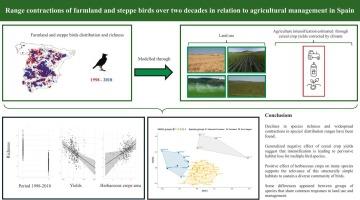二十多年来西班牙农田和草原鸟类的范围缩小与农业管理的关系
IF 4.4
1区 环境科学与生态学
Q1 BIODIVERSITY CONSERVATION
引用次数: 0
摘要
由于农业集约化,欧洲和世界其他地区的农田鸟类数量严重减少。我们评估了1998年至2018年西班牙农田鸟类繁殖季节分布的变化,评估了它们对农业管理的响应。利用广义线性混合模型(glmm),定量分析了严格草原鸟类、农田鸟类和扩展农田鸟类对草原样农田依赖程度不同的3种鸟类种群的分布转移和物种丰富度变化。我们发现,在这20年间,所有三个行业的物种丰富度都在持续下降,物种分布范围也在广泛缩小。农业总利用面积和农业产量产生了普遍的负面影响,表明集约化农业的扩张导致了多种物种普遍的栖息地丧失。相比之下,草本作物对许多物种的分布有积极的影响,突出了这些开放栖息地在支持多样化鸟类群落方面的重要性。正如预期的那样,草原专家——考虑到他们严格的生态要求——显示出最明显的范围下降。然而,一般农田鸟类的数量也大幅减少,这表明即使是不太专业的物种也极易受到当前土地利用集约化水平的影响。这些发现强调了协调农业生产与生物多样性保护的迫切需要。促进可持续土地管理的政策,如欧盟关于自然恢复的第2024/1991号条例(即重建高多样性景观特征,如休耕、轮牧或割草、综合病虫害管理和/或减少农药和化肥的有机农业)中概述的政策,对于阻止农业景观中生物多样性的进一步丧失至关重要。本文章由计算机程序翻译,如有差异,请以英文原文为准。

Range contractions of farmland and steppe birds over two decades in relation to agricultural management in Spain
Farmland birds have experienced severe declines across Europe and other world regions because of agricultural intensification. We assessed changes in the breeding-season distributions of farmland birds in Spain between 1998 and 2018, evaluating their responses to agricultural management at the scale of agricultural counties. Using generalized linear mixed models (GLMMs), we quantified distribution shifts and species richness changes for three bird guilds classified by their dependence on steppe-like farmland: strict steppe birds, farmland birds, and extended-farmland birds.
We found consistent declines over this 20-year period in species richness across all three guilds and widespread contractions in species' distribution ranges. Total utilized agricultural area and agricultural yields exerted generalized negative effects, indicating that the expansion of intensive farming drives pervasive habitat loss for multiple species. In contrast, herbaceous crops had positive effects on the distribution of many species, highlighting the importance of these open habitats in supporting diverse bird communities.
As expected, steppe specialists—given their strict ecological requirements—showed the most pronounced range declines. However, generalist farmland birds also exhibited substantial contractions, revealing that even less specialized species are highly vulnerable to current levels of land-use intensification. These findings underscore the urgent need to reconcile agricultural production with biodiversity conservation. Policies promoting sustainable land management—such as those outlined in the EU Regulation 2024/1991 on nature restoration (i.e. reestablishment of high diversity landscape features like fallows, rotational grazing or mowing, integrated pest management and/or organic farming leading to pesticide and fertiliser reduction)—will be critical to halting further biodiversity loss in agricultural landscapes.
求助全文
通过发布文献求助,成功后即可免费获取论文全文。
去求助
来源期刊

Biological Conservation
环境科学-环境科学
CiteScore
10.20
自引率
3.40%
发文量
295
审稿时长
61 days
期刊介绍:
Biological Conservation is an international leading journal in the discipline of conservation biology. The journal publishes articles spanning a diverse range of fields that contribute to the biological, sociological, and economic dimensions of conservation and natural resource management. The primary aim of Biological Conservation is the publication of high-quality papers that advance the science and practice of conservation, or which demonstrate the application of conservation principles for natural resource management and policy. Therefore it will be of interest to a broad international readership.
 求助内容:
求助内容: 应助结果提醒方式:
应助结果提醒方式:


